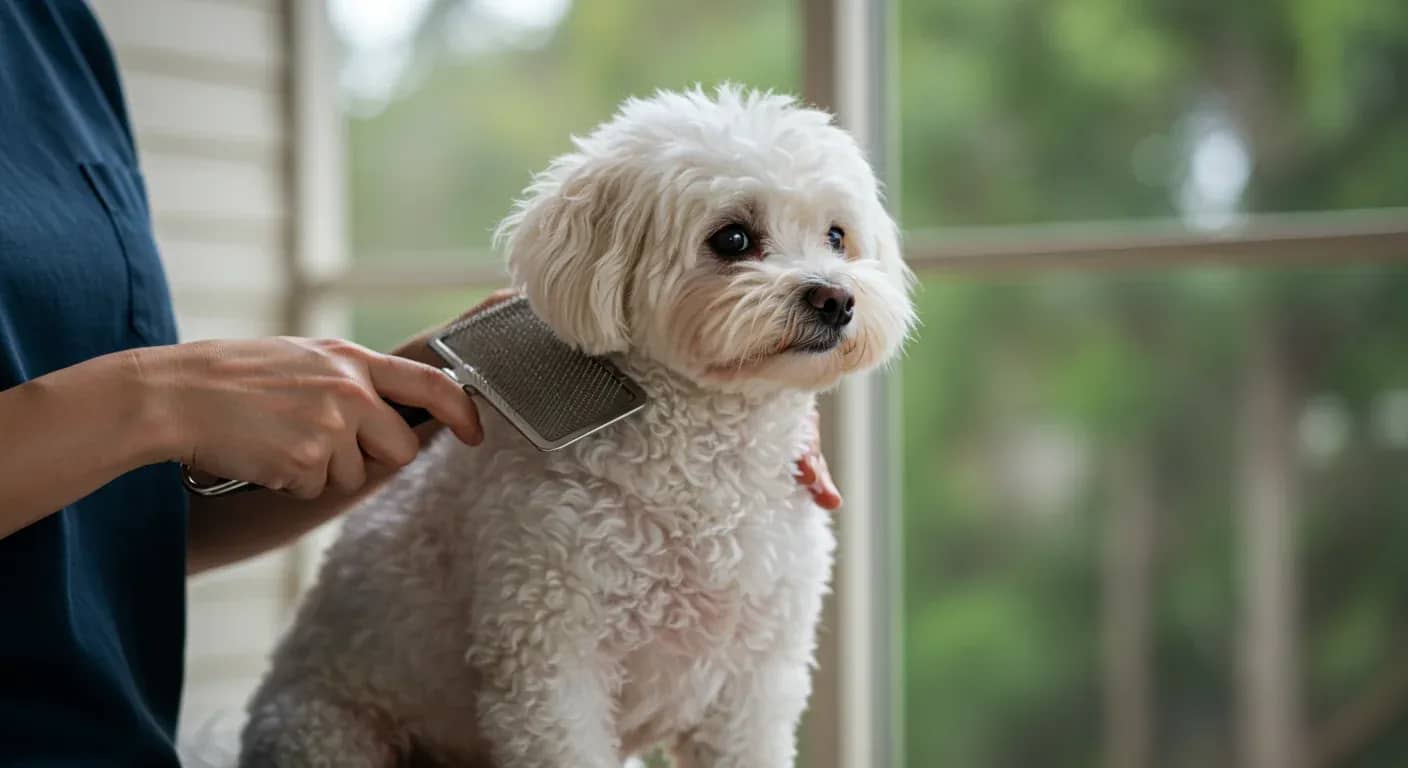At a glance
- Saint Bernards shed moderately year-round with heavy seasonal shedding twice annually in spring and fall
- Both short-haired and long-haired varieties need brushing 2-3 times weekly, increasing to daily during peak shedding seasons
- Use slicker brushes and de-shedding tools for undercoat management, with pin brushes for long-haired varieties
- Bathe only every 6-8 weeks with gentle shampoo to avoid stripping natural oils and causing increased shedding
Understanding your Saint Bernard's double coat
You might notice your Saint Bernard leaving impressive amounts of fur around your home, especially during certain times of year. This isn't unusual behaviour for the breed. These magnificent dogs possess a dense double coat that serves them well in cold conditions but requires dedicated management from owners.
Whether your dog has the short-haired or long-haired variety, both coat types follow the same shedding pattern. They shed moderately throughout the year, but twice annually during spring and fall, you'll encounter what many owners describe as "fur storms." During these seasonal changes, the amount of loose hair can seem overwhelming, particularly given their substantial size.
The double coat consists of a soft, insulating undercoat beneath longer guard hairs. This combination creates excellent protection against weather but also means that when they shed, you're dealing with two distinct types of fur that require different grooming approaches.
Essential brushing techniques for different coat types

Many Saint Bernard owners discover that their usual dog brush simply isn't up to the task. The key lies in matching your tools to your dog's specific coat type and adjusting your technique accordingly.
For managing the undercoat, a slicker brush or specialised de-shedding tool like the Furminator proves most effective. These tools reach through the outer guard hairs to capture loose undercoat before it ends up on your furniture. Work systematically across your dog's body, paying particular attention to areas where fur tends to accumulate, such as the chest, hindquarters, and behind the legs.
Long-haired varieties benefit from a pin brush used gently to remove excess hair and prevent tangles, especially in problem areas behind the ears and around the legs where matting commonly occurs. Short-haired dogs respond well to rubber brushes or grooming gloves, which lift loose hair whilst stimulating the natural oils that keep their coat healthy.
During regular grooming seasons, brushing 2-3 times per week manages most shedding effectively. However, when those seasonal shedding periods arrive, daily brushing becomes essential for keeping loose fur under control and reducing the amount that ends up throughout your home.
Preventing mats and tangles

Have you noticed small knots forming in your dog's coat, particularly after they've been outside or gotten wet? These seemingly minor tangles can quickly develop into painful mats if left unaddressed.
A stainless steel comb becomes your most valuable tool for early intervention. Use it alongside your regular brushing routine to carefully work through any knots as soon as they appear. The metal teeth glide through the coat more effectively than plastic alternatives and won't break when encountering resistance.
Focus your attention on high-risk areas where matting typically begins. The fur behind the ears, under the legs, around the collar area, and anywhere the coat stays damp longer requires extra vigilance. When you find a tangle, work from the outside edges toward the centre, holding the hair close to the skin to avoid pulling uncomfortably.
Regular combing during your brushing sessions prevents most matting issues. If mats do form and resist gentle removal, professional grooming may be necessary to avoid causing skin damage or distress to your dog.
Bathing frequency and proper techniques
Many owners assume that more frequent bathing will help control shedding, but this approach often backfires with these dogs. Their skin produces natural oils that keep both skin and coat healthy, and over-bathing strips away this protection, potentially leading to dry skin and paradoxically increased shedding.
Bathing every 6 to 8 weeks, or when your dog becomes visibly dirty, provides the right balance. Use a high-quality, gentle dog shampoo formulated for sensitive skin to maintain coat health without causing irritation. Products containing oatmeal or aloe often work particularly well for dogs with dense coats.
The drying process requires special attention due to their thick fur. Moisture trapped against the skin can lead to fungal infections or hot spots, particularly problematic in a breed with such dense coverage. Towel dry thoroughly, then use a pet dryer on low heat to ensure complete drying, paying extra attention to areas where the coat is thickest.
Given their substantial size, many owners find bathing challenging. Walk-in showers or professional dog bathing stations make the process more manageable for both you and your dog.
Choosing the right grooming tools
Your success in managing shedding and coat care largely depends on having appropriate tools for the job. Different brushes serve specific purposes, and understanding these differences helps you build an effective grooming kit.
Slicker brushes, typically costing between $15-25, excel at removing loose undercoat and preventing mats. The Hertzko Self-Cleaning Slicker Brush represents a popular choice among owners. For heavy shedding management, de-shedding tools like the Furminator, ranging from $20-35, specifically target the undercoat that causes most household fur accumulation.
Long-haired varieties benefit from quality pin brushes, such as those from Chris Christensen, priced around $20-40. These brushes gently work through the longer outer coat without damaging the hair. Short-haired dogs often respond better to rubber brushes or grooming gloves, like the Kong ZoomGroom or Safari Grooming Glove, available for $10-20.
A stainless steel comb, such as the Andis Steel Comb for $10-15, completes your basic toolkit. For bathing, gentle shampoos like Earthbath Oatmeal & Aloe Shampoo, costing $10-20, provide effective cleansing without harsh chemicals.
Managing seasonal shedding challenges
When those twice-yearly shedding seasons arrive, even experienced owners can feel overwhelmed by the sheer volume of loose fur. Understanding what to expect and having a plan makes these periods much more manageable.
During peak shedding times, increase your brushing frequency to daily sessions. Focus on using de-shedding tools that effectively remove the dead undercoat before it naturally falls out around your home. You'll likely notice that each brushing session produces substantial amounts of loose fur, this is completely normal and actually indicates that your grooming efforts are working.
Diet plays a supporting role in coat health during these periods. A balanced diet rich in omega fatty acids supports skin and coat health, potentially reducing the intensity of seasonal shedding. Many owners notice improvements when feeding high-quality foods or adding omega supplements, though changes typically take several weeks to become apparent.
Consider professional grooming during peak shedding seasons if home management becomes overwhelming. Professional groomers have specialised tools and techniques that can remove more loose undercoat in a single session than most home grooming efforts achieve.
Recognising when professional help is needed
Sometimes grooming challenges exceed what home care can effectively address. Recognising these situations early prevents minor issues from developing into serious problems requiring veterinary intervention.
Severe matting that causes discomfort or creates skin wounds requires professional attention. Attempting to remove heavily matted fur at home often results in accidentally cutting the skin or causing significant distress to your dog. Professional groomers have the tools and experience to safely address these situations.
Signs of skin infection, including redness, swelling, unusual odour, or excessive scratching, warrant veterinary consultation. Persistent hair loss beyond normal shedding patterns may indicate underlying health issues that grooming alone cannot address. Similarly, ear infections or foul odours from the ears, common in breeds with floppy ears, require medical treatment rather than just cleaning.
Regular grooming sessions provide excellent opportunities to inspect your dog's skin for unusual lumps, bumps, or changes that might need veterinary evaluation. Early detection of skin issues often leads to simpler, more effective treatment options.



